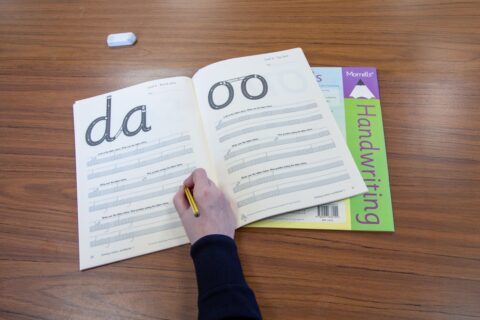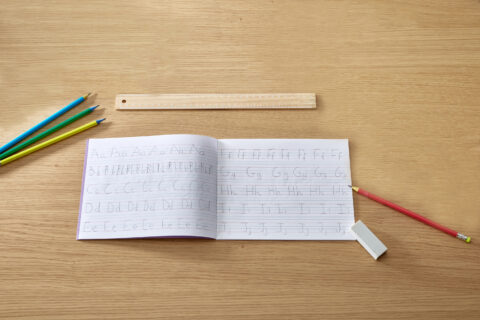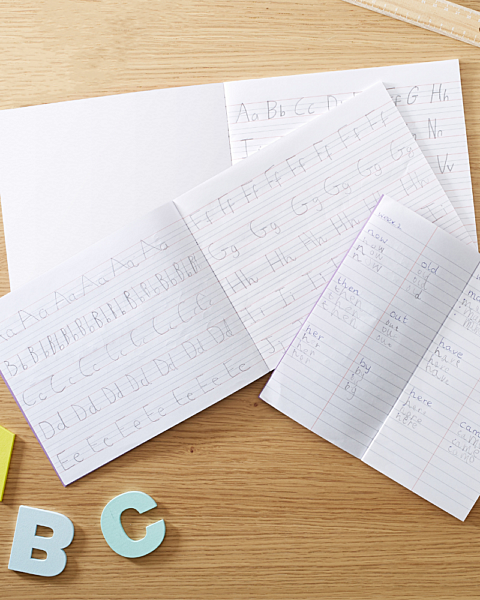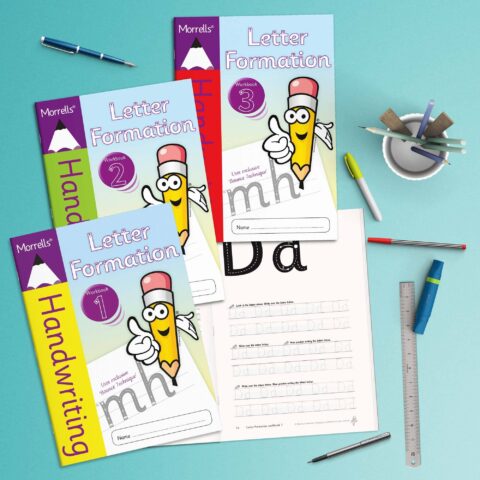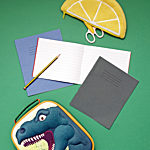Implementing The Writing Framework In The Classroom

Learning to write is one of the hardest challenges pupils face at school but it is vitally important: learning to speak, read and write well are crucial for children and young people’s success in education, life and work. Pupils who find it difficult to express their ideas in writing are likely to struggle across the curriculum, not just in English.
In the rush of a busy school day, writing lessons can sometimes feel like just another box to tick. As a stationery company, we know the right tools, beautiful notebooks, and well-made paper can transform not just the quality of handwriting, but also how children feel about writing. This guide takes the key points from The UK’s Writing Framework and turns them into practical, classroom-ready advice!
The Writing Framework was released by the Department for Education in July 2025 and offers a robust foundation for teaching writing across primary schools. Grounded in research, it provides actionable guidance for Reception through to Key Stage 2, aiming to equip learners with both the mechanics and artistry of writing.
Who’s it for?
- Primary school teachers (Reception through Key Stage 2)
- Early years practitioners
- Secondary teachers who want insight into early writing development
- Specialist settings
- Teacher training providers
What’s New & Important
1. Rooted in Real Classrooms & Research - This isn’t just theory, it’s based on actual teacher experiences, classroom observations, and a long list of expert input.
2. Clear, Practical Guidance - The framework focuses on how to teach writing, from Reception through KS2, including strategies for pupils who need extra support.
3. Mastering the Basics Early
- Transcription first: Handwriting and spelling are the building blocks.
- Teach them early and explicitly in Reception so children develop these skills gradually.
- The aim: free up working memory so pupils can focus on composing great ideas.
4. Writing Struggles Affect Everything
- If a pupil struggles to express themselves in writing, it impacts learning across all subjects (not just English).
5. Talk Matters (A Lot)
- Dialogue isn’t just for reading lessons.
- Pupils should learn to talk in ways that build understanding, this supports their writing skills too.
6. Writing on Paper
- Writing requires control of language in ways that speech doesn’t.
- Pupils need to learn both composition (ideas, structure, style) and transcription (mechanics).
Grip & Positioning
Teachers should encourage pupils to maintain correct finger positioning. Most pupils find the tripod grip the easiest to learn and support grips can help. Teachers should show pupils how to pinch the pencil with the index (‘pointing’) finger and the thumb, about a finger space from the end (on the coloured part just above the sharpened point); and how to rest the middle finger underneath the pencil to support it. If necessary, a sticker can show pupils where to place their fingers. The way a child grips the pencil will affect the quality, speed and flow of the handwriting. The grip should be relaxed, not pressing too hard on the pencil or the paper.
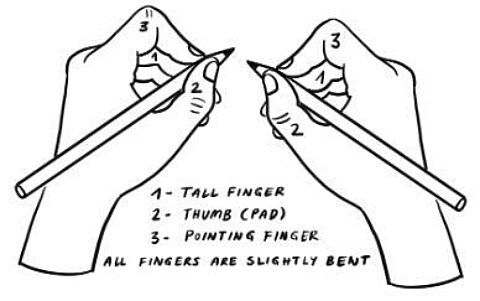
Writing Framework Approved
The Morrells Handwriting Method is aligned and already follows The Writing Framework 2025, Morrells places equal focus on letter groups, body posture, and pencil grip, ensuring that children learn to form letters consistently, sit comfortably, and develop fluency without strain. These practical workbooks and teacher guides help pupils master diagonal and horizontal joins, build confidence in spacing and sizing, and give left- and right-handed learners tailored support. By pairing the expertise of Morrells with the trusted quality of RHINO Stationery, we’re proud to offer schools a complete solution: evidence-based teaching methods matched with the tools and materials that make handwriting practice both effective and enjoyable.
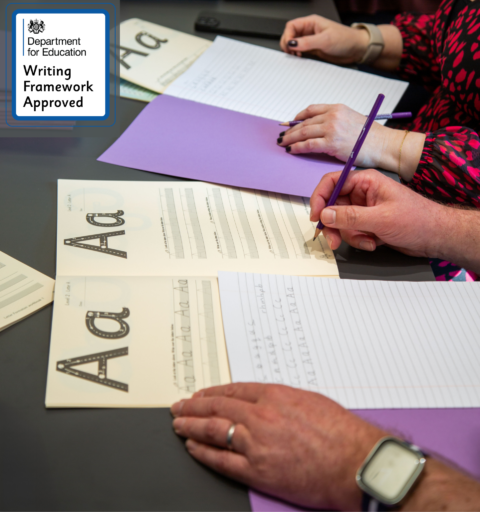
Our wide selection of RHINO Stationery Handwriting Exercise Books are designed to support every stage of a writing journey. Our books give pupils the right structure at the right time. Younger learners can begin with wide-ruled pages that provide generous spacing and clear red and grey guide lines to build confidence with letter size and proportion. As their handwriting becomes more fluent, children can naturally progress into narrower-ruled books, refining control and developing a consistent, neat style. Teachers can choose from a variety of sizes and rulings, making it easy to match resources to each stage of learning. And because every RHINO book is made to education-standard quality, sustainably sourced, and fully recyclable, schools can trust they’re investing in durable, eco-conscious tools that really make a difference.

The Writing Framework July 2025
Section 1: The importance of writing and a conceptual model
The new guidance makes it clear: writing matters a lot. It’s not just a school skill, but a lifelong tool for thinking, expressing, and creating.
- Start early: Handwriting + phonics from Reception, with spelling taught systematically and practised (yes, even through dictation).
- Go deeper: Move from basic phonics to orthography, morphology, and etymology. (Orthography = how we spell & write words, Morphology = how words are built, Etymology = where words come from.)
- Keep handwriting strong: Fluent handwriting still helps produce better writing (memory, focus, deeper engagement).
- Master sentences: Clear, correct sentences are the building blocks of all good writing.
- Include everyone: Give all pupils, including those with complex needs, high-quality writing instruction and support gaps in the lesson.
- Secondary matters: Writing instruction continues, with pupils adapting to different subjects - early literacy gaps make everything harder.
- Creativity counts: Writing boosts wellbeing, self-expression, and imagination.
- Lead well: A strong writing lead should sequence the curriculum across Reception–Y6 (ideally alongside reading).
- Talk & write: Use talk to spark ideas, and writing to prepare for speaking.
A foundational part of teaching writing is about ensuring pupils master the functional aspects of writing as early as possible.
Section 2: The importance of reception/ first year of primary school
The first year of primary is where pupils lay the foundations for a lifetime of writing, and nothing beats pen on paper for building those skills. The emphasis here is on daily, deliberate practice so that letter formation becomes automatic and fluent, freeing up little minds to focus on ideas, not grip strength.
Teachers should think less about how much children write and more about how well they form letters and spell. Making pencils and paper a constant, natural part of the classroom, helps children see writing as both fun and functional.
Daily practice matters: Correct letter formation should be taught and practised regularly until it’s effortless.
Start with movement: Some children need to develop thumb, wrist, and shoulder control before forming letters.
Build physical foundations: Focus on gross and fine motor skills, core strength, balance, and precision.
Support early writing attempts: From scribbles to single letters to names, celebrate children seeing themselves as “writers”.
Paper within reach: Keep pencils and paper everywhere so writing naturally happens during play.
Clear expectations for early goals:
Writing can be from dictation.
Keep sentences short and simple.
Readable, even if not perfect in spelling or letter formation.
Punctuation not essential at this stage.
Section 3: Transcription: handwriting and spelling
Handwriting is the quiet engine that powers great writing, fluent penmanship frees pupils to focus on ideas, not the mechanics of forming letters. Without it, writing becomes slow, frustrating, and hard to read. That’s why teaching handwriting from Reception is essential, with daily, structured practice on real paper and the right tools. Good posture, pencil grip, and line guides all help, as does modelling high standards in every subject. Alongside this, spelling should be practised regularly, ideally with pen on paper, so pupils commit words to memory through the physical act of writing.
Automaticity matters: Fluent handwriting means pupils can plan, compose, and revise without distraction.
Model excellence: Teachers’ own handwriting should set the standard across the curriculum.
Daily, step-by-step instruction: Start in Reception; consolidate before moving on.
Year 1 focus: Pencil grip, letter families, digits, and correct letter direction — wide-lined paper is key.
Year 2 focus: Consistent sizing, spacing, and early joins; use narrower lines once legibility is secure.
Posture and positioning: Feet flat, paper steady, comfortable seating; correct poor habits early.
Left-handed adaptations: Space to write, paper slanted right, softer pencils, and grip adjustments to avoid smudging.
Spelling routines:
Pre-teach new words before they appear in texts.
Revisit taught words for speed and accuracy.
Include handwriting tasks with spelling practice to boost retention.
Explore word structure and patterns (morphology).
Section 4: Composition
Strong writing starts with strong sentences before pupils tackle full pages, they need plenty of low-pressure practice crafting, improving, and playing with sentence structures. This is best done with pen and paper in short, focused activities that help pupils think about grammar, vocabulary, and meaning without being overwhelmed by length. Good composition also relies on rich vocabulary, which should be introduced in meaningful ways and revisited often so pupils can use it confidently in their own writing.
Master the sentence first:
Combine fragments into complete sentences.
Merge short sentences into one accurate, longer sentence.
Fix faulty sentence structures.
Add detail using conjunctions, adverbials, or the passive voice.
Use all four sentence types: statements, questions, commands, and exclamations.
Use images or animations to spark ideas without overloading working memory.
Grow vocabulary with intention:
Explain new words in everyday language, not dictionary jargon.
Explore words in multiple contexts — through talk, reading, and writing on paper.
Analyse morphology and etymology for deeper understanding.
Use visuals or real objects to anchor meaning.
Give pupils engaging activities that make them think about and apply new words.
Revisit words regularly with retrieval tasks so they stick.
Section 5: Pupils who need the most support
Every child should experience early writing success, frequent, positive moments with pen and paper keep motivation high and build confidence. Teachers need to spot early signs of difficulty and intervene quickly, especially for disadvantaged pupils.
Struggles can show up in slow writing, difficulty transferring skills, lack of motivation, or quietness in class.
Often, the challenge lies in handwriting itself, if forming letters is laborious, pupils’ working memory gets overloaded, making composition harder. That’s why targeted support, patient instruction, and plenty of practice on paper are crucial.
Spot early signs: Slow writing, poor letter formation, awkward pencil grip, demotivation, or trouble applying skills in new contexts.
Handwriting focus:
Observe letter formation closely; correct stroke direction and sequence.
Give individual support during handwriting lessons.
Provide daily, urgent practice until fluency improves.
Offer extra time for writing tasks if needed.
Dyslexia:
Teach writing in smaller steps with repetition.
Reduce cognitive load — plan orally, use colour coding, model aloud.
Let pupils compose without transcription through dictation or peer writing.
Teach orthography, morphology, and etymology explicitly.
Developmental Coordination Disorder / Dyspraxia:
Extra handwriting intervention to build movement skills.
Watch pupils write to identify missed, added, or incorrect strokes.
Tailor support to co-occurring needs (reading, spelling, attention).
If using technology, teach these skills explicitly and alongside handwriting.
Section 6: Writing across the curriculum
Writing benefits all subjects, not just English! Linking writing tasks to wider learning gives pupils meaningful reasons to put pen to paper, and skills learned in writing lessons should be applied in history, science, geography, etc.
Connect lessons: Use knowledge from other subjects to inspire writing tasks.
Apply skills widely: Give pupils opportunities to practise grammar, vocabulary, and sentence structures in non-English work.
Purpose matters: Writing feels more engaging when it’s tied to real learning experiences.
Section 7: Leadership and management of writing
A strong school writing culture starts at the top. Making sure every teacher is trained to teach writing — not just the English lead. This culture values the visible process of putting ideas on paper and recognises writing as a school-wide priority.
A strong writing culture starts with leadership. School leaders set clear expectations, build a sequenced curriculum, and ensure every teacher — not just English specialists — is confident teaching writing. It’s a culture that values the visible act of putting ideas on paper and treats writing as a whole-school priority.
Lead by example: Headteachers model commitment to writing.
Train all staff: Every teacher should understand how to support writing development.
Set the tone: Build a positive, supportive environment where pupils feel confident to write.
Section 8: National assessments
Tests like the English grammar, punctuation, and spelling paper assess certain skills, but high scores don’t always mean pupils can construct strong, meaningful sentences.
Teaching should go beyond test prep, focusing on genuine writing ability — best developed through sustained, thoughtful work on paper.
Grip and posture matter:
Teach and maintain a relaxed tripod grip (thumb and index pinch, middle finger supports).
Use finger-space stickers or visual guides if needed.
Avoid pressing too hard — it slows writing and strains the hand.
Sit comfortably: feet flat, paper steady, posture upright.
Link grip to quality: The way pupils hold a pencil affects their writing’s speed, flow, and legibility.

Left-Handed Children (All Ages)
About 10% of children are left-handed and face unique challenges, including smudging, obscured writing, and spacing difficulties.
Support Strategies:
- Seat left-handers to the left of right-handers avoid arm collisions
- Slant paper 45° clockwise
- Adjust pencil grip and materials
- Demonstrate techniques rather than just mirroring right-handed instruction

Children Who Need Extra Support
Some children may require additional help due to handwriting difficulties such as; dyslexia, developmental coordination disorder (DCD), dyspraxia, or other learning needs. Key principles to bear in mind are:
- Early identification of difficulties
- Support during writing lessons, not just separate interventions
- Scaffold composition with sentence stems and oral rehearsal
- Use assistive technology carefully to complement handwriting instruction
The Practical Takeaways
- Start handwriting early: Reception is the time to build strong foundations
- Sentences before stories: Focus on sentence mastery before expecting long compositions
- Oral composition: Encourage children to speak ideas aloud first
- Quality over quantity: One clear, well-written paragraph is better than several confusing pages
- Writing is everyone’s responsibility: Every teacher and parent plays a role
By combining systematic teaching, regular practice, and supportive feedback, all children can become confident writers who enjoy expressing themselves, whether it’s in a notebook, a storybook, or across the curriculum.
Read the full 2025 Writing Framework here:
Download the official PDF from the Department for Education
Ready to put great handwriting into practice?
Our RHINO selection of handwriting books make it simple for schools, teachers and educators to put the writing framework guidance into place, from wide-ruled early literacy books that young learners start off using to build confidence to narrow-ruled formats that extend their writing skills, our range grows with your pupils.
Morrells Handwriting & RHINO Stationery support pupils with:
- Letter families and joins
- Correct grip and posture
- Tailored guidance for left and right-handed writers
Now available to order directly through RHINO Stationery. Shop Morrells Handwriting or explore our full RHINO Handwriting range.


